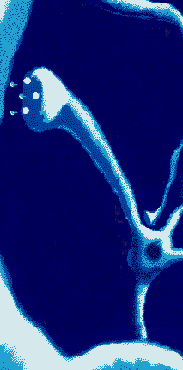
|

Mission Statement
Goals in Basic Neuroscience
- Continue and expand molecular structure-function studies to improve definition of molecular sites of abused drug action and possible therapeutic targets.
- Elucidate cellular mechanisms of peptide trafficking, receptor signal transduction and gene regulation relevant to addiction.
- Investigate "cross-talk" between brain structures and reward systems
- Determine neurobiological events underlying vulnerability factors in drug taking (environmental, physiological/genetic, cognitive).
- Develop new animal models for understanding drug taking and its consequences.
- Determine the neurobiological bases of addiction as a possible manifestation of learning or memory.
- Understand the mechanisms and consequences of prenatal and perinatal drug exposure.
- Elucidate neurobiological mechanisms underlying pain and analgesia.
- Elucidate pharmacologically induced neural plasticity.
- Extend the mapping of the neuroanatomy and neurochemistry of the brain reward system as it relates to reward, dysphoria, withdrawal and craving.
- Determine the effects of drug abuse on neuro-endocrine, immune and autonomic systems.
- Elucidate gender differences in the neurobiology of addiction.
- Develop neurobehavioral models of risk-taking and self control.
- Understand the neurobehavioral bases of addiction using animal and human laboratory models of tolerance, dependence, sensitization, and craving.
- Examine the role of environmental factors and their neurobehavioral correlates in modulating drug abuse.
Goals in Clinical Neuroscience
- Expand research on the effects of drugs of abuse and addiction on the structure and function of the human brain
- Determine the effects upon human brain of pharmacological, non-pharmacological, and behavioral treatments for drug abuse and addiction
- Characterize in detail the neurobiology of addiction from initiation of drug use to addiction and from withdrawal to craving to relapse.
- Identify the role of etiological factors in the progression from initiation of drug abuse to drug addiction
- Investigate the neurobiological underpinnings of differences between individuals and populations in drug abuse patterns.
- Elucidate the pharmacokinetics and pharmacodynamics of drugs of abuse and therapeutic drugs in the human brain.
- Expand research on the effects of acute and chronic exposure to drugs of abuse on CNS development and maturation.
- Understand the interactions between drugs of abuse AIDS-HIV encephalopathy.
- Determine the neurobiological, etiologic and mechanistic relationships of drug abuse and mental disorders.
- Determine the effects of drugs of abuse on cognitive processes as well as the role of cognitive processes in drug-seeking behavior.
- Support research through the Human Brain Project to map the human brain from the molecular to the behavioral level using technologies of informatics and computer science to advance neuroscience research.
Goals in Medications Development
- Build on the identification of the dopamine transporter for cocaine abuse and addiction.
- Build on cloning of the mu, kappa, and delta opiate receptors in developing medications for opiate abuse and addiction.
- Investigate the locus and mechanism of action of potential medications for opiate abuse and addiction.
- Explore the therapeutic potential of catalytic antibodies and other immunological approaches for the management of cocaine dependence.
Current Membership
Related Program Announcements
- RFA-DA-03-004 Chronic Stress and Its Relation to Drug Abuse and Addiction
[Receipt Date: December 19, 2002]
- PA-02-095 Chemistry, Pharmacology, and Toxicology of Smoked Drugs of Abuse - April 3, 2002
- PA-02-085 Neuroscience Research on Drug Addiction - March 18, 2002
- PAR-02-058 Imaging - Science Track Award For Research Transition (I/START) [Single one time receipt date of May 14, 2002, then standard receipt dates] - February 6, 2002
- PAR-02-016 Minority Institutions Drug Abuse Research Development Program (MIDARP) - October 22, 2001
- PA-01-048 Prescription Drug Abuse - February 12, 2001
- PAR-01-047 Cutting-Edge Basic Research Awards (CEBRA) - [Single one time receipt date of April 17, 2001, then standard receipt dates] - February 6, 2001
- PA-00-115 Molecular Genetics of Drug Addiction Vulnerability - June 27, 2000
- PAR-00-059 NIDA Small Grant Program (R03) (Replaced see PA-02-170) - February 10, 2000
Other Sites of Interest
|

|
About NIDA Contents

|
|